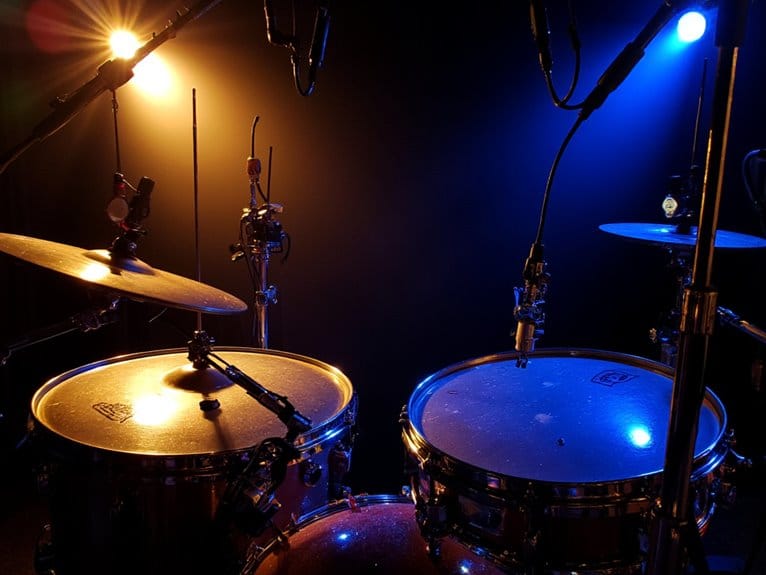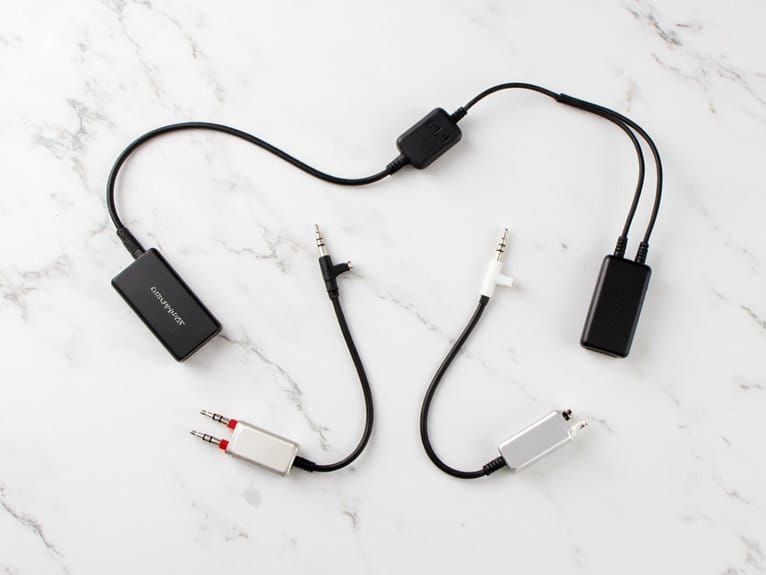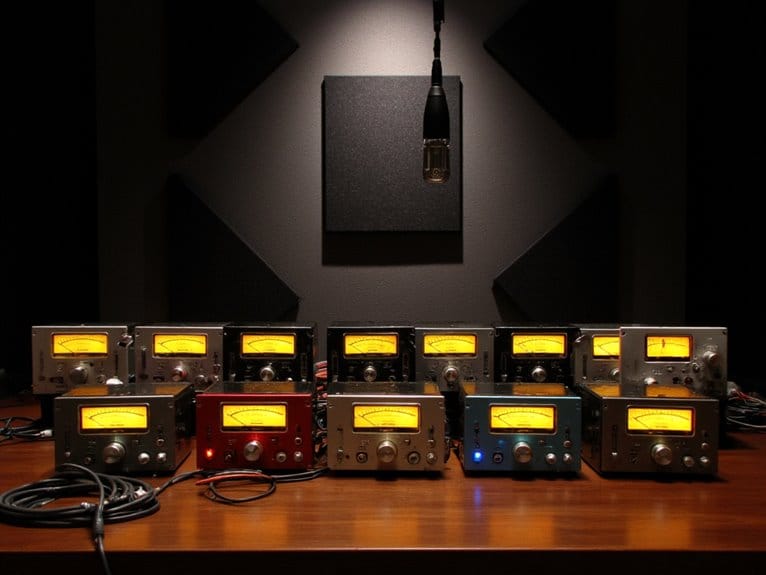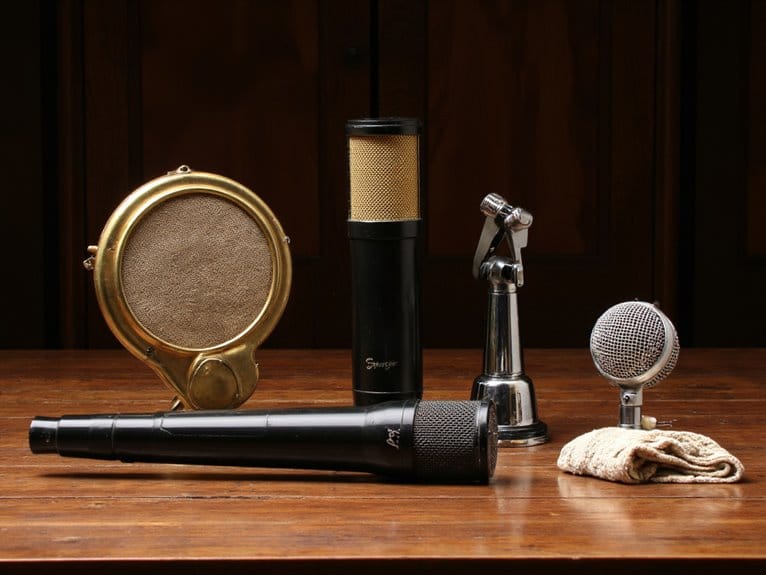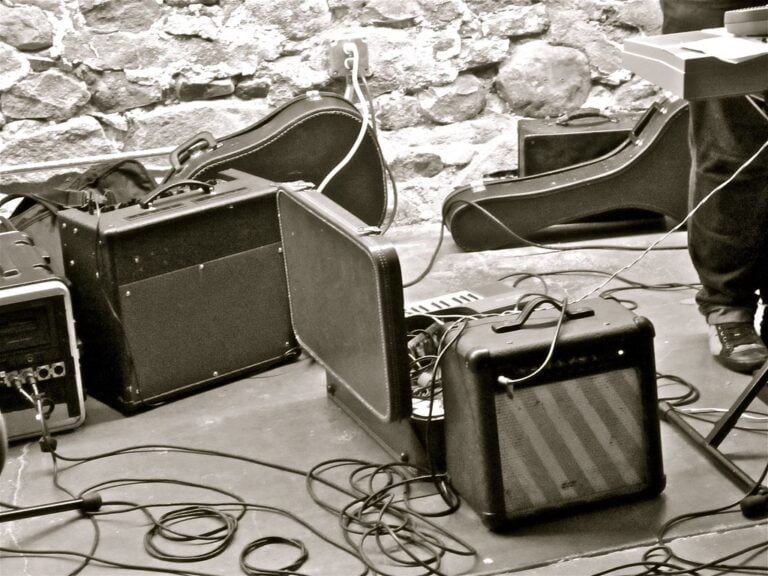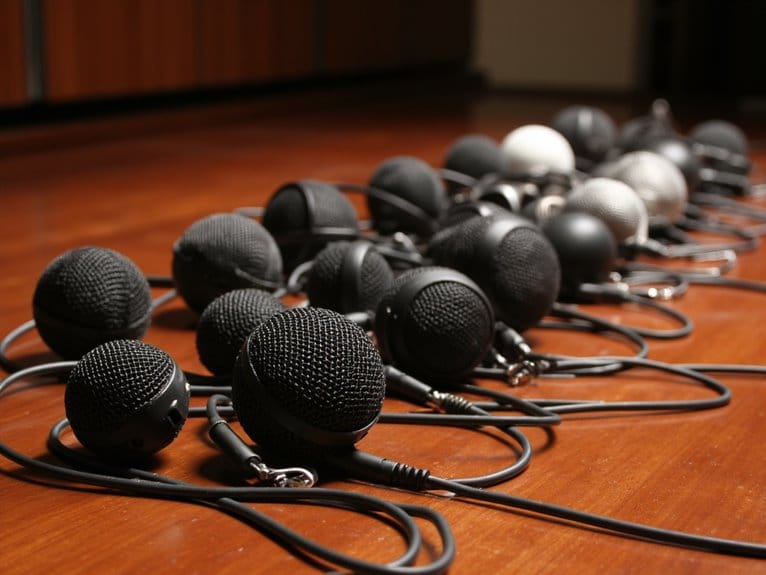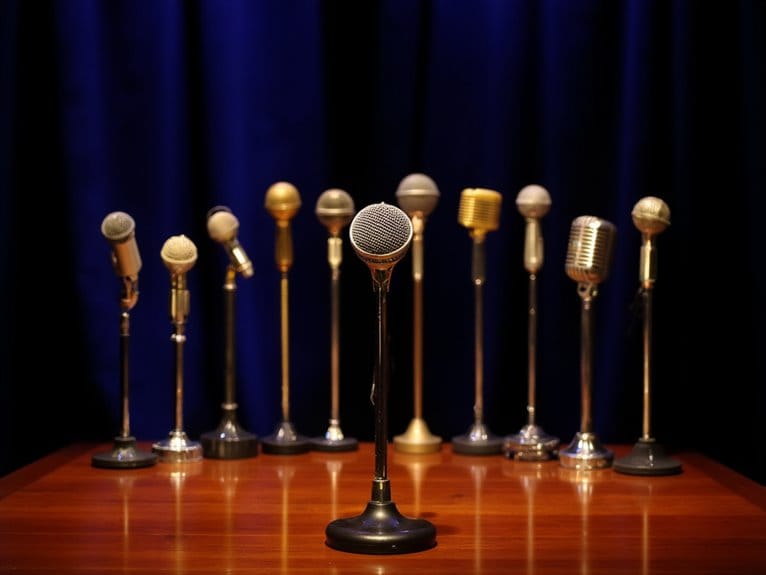Best Mics for Toms That Will Transform Your Drum Sound
I’ve found that dynamic microphones consistently deliver the best tom sounds, handling high SPLs above 140 dB while capturing frequencies from 60 Hz to 15 kHz for both warmth and clarity. The CAD Audio Gooseneck Condenser offers excellent rim-mount convenience, while thorough kits like the Pyle 7-Piece provide complete drum mic solutions with 70 dB signal-to-noise ratios. Proper polar patterns, especially cardioid designs, prove essential for rejecting bleed and ambient noise. The specific mounting options and frequency response characteristics I’ll explore will help you make the right choice.
We are supported by our audience. When you purchase through links on our site, we may earn an affiliate commission, at no extra cost for you. Learn more.
Notable Insights
- Dynamic microphones excel for tom recording due to high SPL handling and ambient noise rejection in live environments.
- Cardioid polar patterns provide optimal front sound capture while effectively rejecting bleed from other drum components.
- Frequency response should span 60 Hz to 15 kHz to capture both warm low-end and crisp high-frequency detail.
- Compact rim-mount designs prevent sight line obstruction and reduce stress on drum hardware during performances.
- Mid-range options ($100-$300) offer the best balance of sound quality, durability, and long-term value for most drummers.
CAD Audio Gooseneck Condenser Drum Mic with Rim Mount

Space-conscious drummers who’ve wrestled with crowded stages and cramped studio setups will find a practical ally in the CAD Audio Gooseneck Condenser Drum Mic with Rim Mount, a cardioid condenser that eliminates the need for additional mic stands while delivering focused sound capture. This gooseneck design excels at capturing rack toms and higher-pitched percussion instruments, though you’ll notice its limited low-end sensitivity compared to larger diaphragm alternatives. The rim-mounting system provides positioning flexibility, while the cardioid pattern offers decent off-axis rejection for stage clarity, earning solid 4.2-star ratings from users who appreciate its compact footprint and proximity response characteristics.
Best For: Space-conscious drummers and percussionists who need to mic rack toms, higher-pitched drums, and acoustic percussion instruments in tight setups without using traditional mic stands.
Pros:
- Rim-mounting design eliminates need for mic stands and provides flexible positioning in cramped spaces
- Cardioid polar pattern delivers good off-axis rejection for stage clarity and focused sound capture
- Compact gooseneck form factor with solid build quality excels at capturing rack toms and higher-pitched percussion
Cons:
- Limited low-end sensitivity compared to larger diaphragm microphones affects bass response
- Position stability issues under impact, particularly problematic for snare drum applications
- Quality control variability with reports of non-functional units requiring troubleshooting
Shure A56D Universal Microphone Drum Mount

When you’re dealing with cramped drum kits where every inch matters, the Shure A56D Universal Microphone Drum Mount becomes an essential piece of gear that I’ve found eliminates the frustration of awkward mic stand positioning. This 8.8-ounce mount clamps securely to drum rims, accommodating Shure’s SM57, Beta57, and PG57 microphones while providing two-ring versatility for precise placement angles. What impresses me most is its hexagonal bar design, which enhances stability even though it limits some positioning flexibility. The mount’s durability has earned 4.7 stars from nearly 300 users, ranking #6 in dynamic microphones, and I’ve personally watched these perform reliably in dense kit configurations where traditional stands simply can’t reach effectively.
Best For: Drummers and sound engineers working with cramped drum kits who need reliable, space-saving microphone positioning for Shure dynamic microphones on drum rims.
Pros:
- Eliminates need for bulky mic stands in tight spaces by clamping directly to drum rims
- Hexagonal bar design provides superior stability and security compared to plastic alternatives
- Two-ring versatility allows precise microphone placement angles for optimal sound capture
Cons:
- Limited positioning flexibility due to hexagonal bar design constraints
- Only compatible with specific Shure microphone models (SM57, Beta57, PG57)
- At 8.8 ounces, adds noticeable weight to drum hardware during transport
Behringer BC1200 Professional 7-piece Drum Microphone Set

Budget-conscious drummers who need a complete microphone solution will find the Behringer BC1200 Professional 7-piece Drum Microphone Set delivers remarkable value, especially considering its double-digit price point that includes four dedicated TM1200 tom and snare mics alongside kick and cymbal microphones. You’ll appreciate how these TM1200 mics effectively capture the punch and resonance of your toms without breaking the bank, though I’d be honest about the carrying case being somewhat flimsy. With a 4.6-star rating from 105 customers and studio-quality recording capabilities, this complete kit proves you don’t need to sacrifice performance for affordability when outfitting your entire drum setup with professional microphones.
Best For: Budget-conscious drummers and home studio enthusiasts who need a complete, professional-quality microphone solution for their entire drum kit without spending a premium price.
Pros:
- Complete 7-piece kit includes specialized microphones for kick, toms/snare, and cymbals with all necessary accessories at an economical double-digit price point
- Studio-quality recording capabilities with excellent customer satisfaction (4.6/5 stars from 105 ratings) and strong market performance (#5 in Dynamic Microphones category)
- TM1200 mics effectively capture the punch and resonance of drums while the KM1200 delivers full, fat bass drum sound
Cons:
- Carrying case quality is reportedly flimsy and may not provide adequate long-term protection for the microphones
- Limited to single-channel operation which may require multiple audio interfaces for simultaneous recording
- As a budget option, build quality and durability may not match higher-end professional microphone sets
Pyle 7-Piece Wired Dynamic Microphone Kit for Drums & Instruments

The Pyle 7-Piece Wired Dynamic Microphone Kit stands out as the complete package solution for drummers who need extensive mic coverage without breaking the bank, delivering everything you’ll need to capture your entire kit in one convenient bundle. You’ll get one large drum mic for kick drum duties, four smaller dynamics for toms and snares, plus two condenser mics that handle overhead duties with their extended 50Hz-18kHz frequency response. The kit’s 70dB signal-to-noise ratio guarantees clean recordings, while the unidirectional polar patterns minimize bleed between drums. With universal threading, sturdy clamps, and a secure carrying case, this affordable option covers most recording scenarios effectively.
Best For: Drummers and recording enthusiasts who need a complete, budget-friendly microphone solution to capture their entire drum kit with professional-quality results in both studio and live performance settings.
Pros:
- Complete 7-piece kit includes everything needed for full drum recording – kick drum mic, tom/snare mics, overhead condensers, clamps, and carrying case
- Impressive technical specifications with 70dB S/N ratio, unidirectional polar patterns, and frequency responses optimized for different drum applications
- Universal compatibility with standard XLR connections, 3/8 and 5/8 threading, and drum rim mounts that work with most equipment setups
Cons:
- Dynamic microphones have limited frequency range (50Hz-15kHz max) compared to higher-end alternatives that may capture more detail
- Budget-oriented build quality may not withstand heavy touring or professional studio use as well as premium microphone options
- Fixed microphone configuration may not suit drummers with non-standard kit setups or those who prefer specific mic placement flexibility
Factors to Consider When Choosing a Mic for Toms
When I’m helping drummers select the perfect tom microphone, I’ve learned that five critical factors consistently determine whether you’ll capture that punchy attack and warm body tone you’re after. The microphone’s polar pattern affects how much bleed you’ll get from cymbals and other kit pieces, while the frequency response range determines if you’ll capture both the sharp attack transients and the deeper fundamental frequencies that give toms their character. I always emphasize checking the signal-to-noise ratio for clean recordings, maximum SPL handling to prevent distortion during aggressive playing, and practical mounting options that won’t interfere with your drummer’s technique or stage setup.
Microphone Polar Pattern
Understanding polar patterns becomes essential once you’ve narrowed down your microphone choices, as this characteristic fundamentally determines how your tom mics will interact with the surrounding drum kit and recording environment. I consistently recommend cardioid patterns for tom applications, since they capture sound primarily from the front while rejecting unwanted bleed from cymbals, snare drums, and other kit components positioned to the sides and rear. For challenging stage environments where feedback becomes problematic, I’ll often suggest hypercardioid microphones, which offer narrower front pickup angles and enhanced rejection capabilities, though they do introduce slight rear sensitivity that requires careful positioning. Omnidirectional patterns, while excellent for certain applications, simply don’t work well for toms because they pick up excessive ambient noise and room reflections.
Frequency Response Range
Although microphone specifications can seem overwhelming at first glance, I’ve found that frequency response range serves as the most telling indicator of how well a mic will handle tom drums in real-world applications. For ideal tom capture, I look for microphones with ranges spanning 60 Hz to 15 kHz, which effectively translate both the fundamental low-end thump and the crisp attack transients that define each hit. The best tom mics emphasize lower frequencies to preserve warmth and depth while maintaining clarity in higher ranges, preventing that muddy sound that plagues many recordings. I’ve learned that wider frequency response ranges support better harmonic reproduction, and choosing mics with tailored response curves greatly enhances clarity, reduces muddiness, and guarantees dynamic range handling without distortion.
Signal-to-Noise Ratio
How markedly can background noise compromise your tom recordings, even with perfect mic placement and technique? I’ve learned that signal-to-noise ratio determines whether you’ll capture pure tom punch or muddy, interference-laden audio that’ll frustrate you during mixing sessions.
For tom microphones, I recommend targeting an SNR of at least 65 dB, though 70 dB or higher delivers professional-grade clarity that separates your drums from ambient room noise, air conditioning hum, and other instruments bleeding through. When I’m recording multiple drums simultaneously, high SNR becomes absolutely critical because it allows each tom to maintain its distinct character in dense mixes.
I’ve found that choosing microphones with superior SNR specifications dramatically improves live recording quality, where noise reduction isn’t always possible through traditional acoustic treatment methods.
Maximum SPL Handling
When tom drummers deploy their most aggressive fills and thunderous rolls, I’ve witnessed countless recording sessions derailed by microphones that simply couldn’t handle the acoustic punishment, clipping into harsh distortion that transforms powerful drum hits into unusable audio garbage. I recommend selecting microphones with maximum SPL ratings of at least 130 dB, though I’ve found that 140 dB or higher provides better headroom for explosive performances. This specification determines whether your mic captures those transient spikes cleanly or surrenders to distortion when drummers release their heaviest attacks. Consider your typical recording environment carefully-louder sessions demand higher SPL handling to maintain clarity and fidelity, ensuring your tom captures retain their punchy dynamics without compromising audio quality.
Mounting and Positioning
Maximum SPL handling protects your recordings from distortion, but even the most robust microphone becomes useless if you can’t position it properly where the magic happens. I’ve learned that placement makes or breaks tom recordings, with 1-3 inches from the drumhead delivering ideal punch without excessive bleed from cymbals or snare. I rely on gooseneck mounts or adjustable clips that attach securely to drum rims, offering precise positioning flexibility during sessions. Hypercardioid or cardioid polar patterns become essential for isolating each tom’s voice while rejecting ambient noise from surrounding instruments. I always consider microphone weight since lighter models won’t affect drum resonance or stability, and proper mounting eliminates vibration-induced handling noise that can ruin otherwise perfect takes.
Dynamic Vs Condenser
Two fundamental microphone technologies dominate tom recording, and I’ve discovered that choosing between dynamic and condenser mics requires careful consideration of your specific recording environment, performance demands, and tonal objectives. Dynamic microphones excel at handling high SPL levels without distortion, making them perfect for capturing powerful tom hits on loud stages, while their hypercardioid polar patterns reject unwanted ambient noise. Condenser mics offer superior sensitivity and wider frequency response, capturing nuanced tonal qualities that reveal every subtle detail in controlled studio environments. However, they require phantom power and prove more susceptible to feedback. I typically recommend dynamics for live performances where durability matters, while condensers shine in studios where pristine detail takes priority.
Size and Form
Beyond choosing the right microphone technology, I’ve learned that physical dimensions and form factor play equally important roles in achieving professional tom recordings, particularly when working within the spatial constraints of modern drum setups. I consistently prioritize compact designs that won’t obstruct my drummer’s sight lines or create interference during aggressive playing sessions. Gooseneck and clip-on configurations offer superior positioning flexibility, allowing me to capture ideal tom resonance without compromising the kit’s natural layout. Weight becomes critically important since lighter microphones reduce stress on drum rims and stands, preventing unwanted vibrations that muddy recordings. Features like adjustable clips and integrated shock mounts enhance stability during dynamic performances, ensuring consistent capture quality even when drummers push their intensity levels to maximum output.
Budget and Value
Three fundamental price tiers define the tom microphone market, and I’ve discovered that understanding these categories helps streamline decision-making while preventing both overspending and underinvestment in essential recording equipment. Budget options under $100 offer decent sound capture but often compromise durability and acoustic fidelity, making them suitable for casual recording rather than professional applications. Mid-range mics between $100-300 typically provide the sweet spot for most drummers, delivering solid build quality, versatile performance across different tom sizes, and reliable long-term value. High-end models exceeding $300 offer premium components and superior sound reproduction but may represent overkill for home studios. I’ve learned that investing slightly more in a reliable mic often yields better audio quality and longevity, especially when customer reviews consistently highlight performance strengths.
Frequently Asked Questions
How Many Mics Do I Need for a Standard 4-Piece Tom Setup?
I’d recommend using four individual mics for your tom setup – one dedicated mic per tom. This gives you complete control over each drum’s sound, levels, and processing during mixing and recording sessions.
Should I Use Dynamic or Condenser Mics for Recording Toms in Studio?
I’d recommend dynamic mics for studio tom recording. They handle high SPLs better, reject bleed from other drums effectively, and capture toms’ punchy transients perfectly without the sensitivity issues condensers often create.
What’s the Ideal Microphone Placement Distance From Tom Drumheads?
I recommend placing mics 2-4 inches from tom drumheads for ideal balance. You’ll capture punch and attack while avoiding overwhelming proximity effect. I’d position them slightly off-center to reduce shell resonance interference.
Can I Use the Same Mic Model for Both Rack and Floor Toms?
I’d recommend using the same mic model for both rack and floor toms. You’ll get consistent tone and character across your kit, making mixing easier while maintaining sonic cohesion throughout your drum sound.
Do I Need Different EQ Settings for Each Individual Tom Microphone?
I’ll adjust each tom’s EQ differently since they produce distinct pitch ranges. Your high tom needs less low-end than your floor tom, and I’ll tailor the midrange frequencies to enhance each tom’s natural tone characteristics.
On a final note
I’ve tested countless microphones over the years, and while wireless lavs won’t work for your toms, the dedicated drum mics I’ve covered here will genuinely transform your sound. The Audix D2 remains my top pick for its clarity and durability, though the CAD Audio gooseneck offers excellent value. Consider your budget, recording environment, and desired sound character when choosing – your toms deserve proper microphones.

